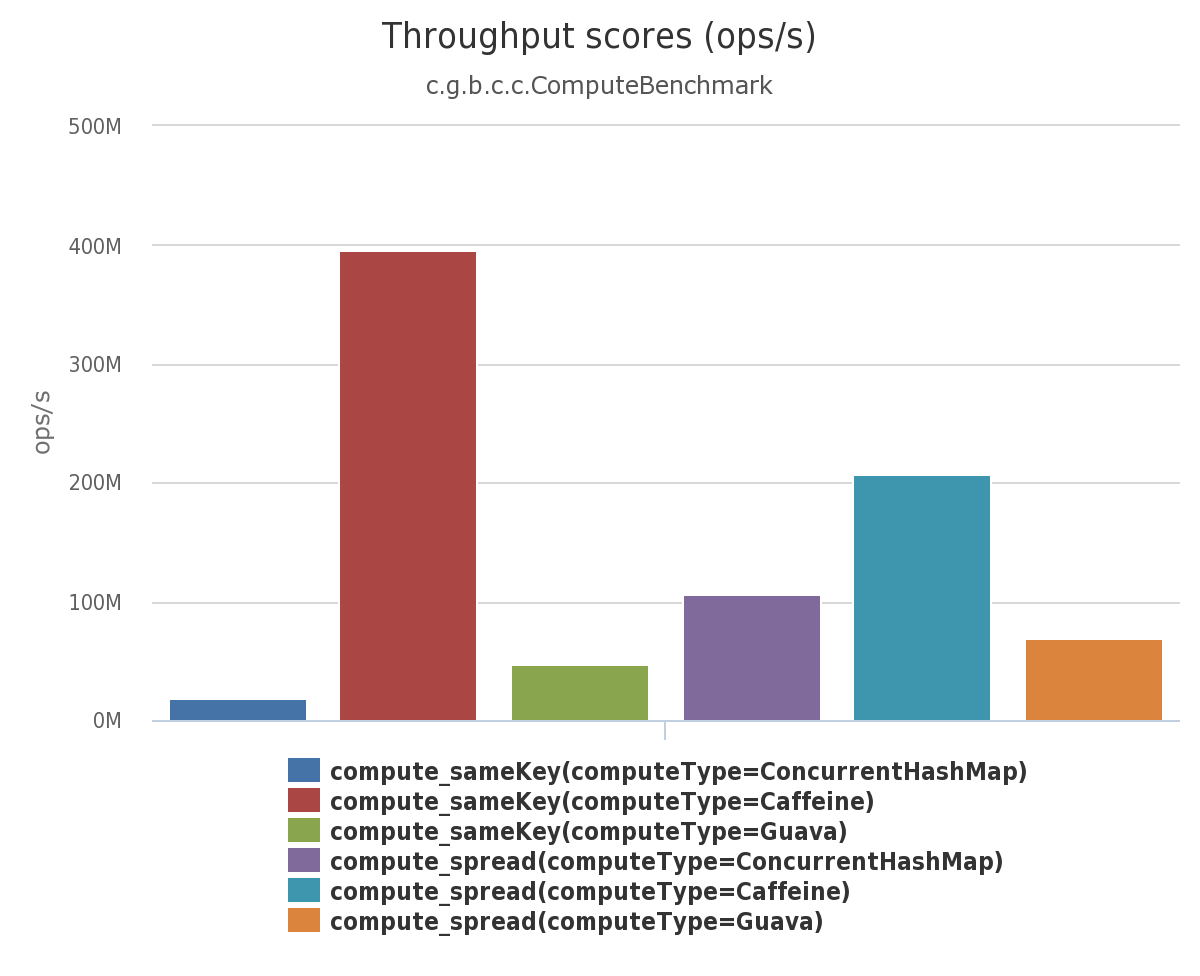作者:杨贤 达摩院 AI 开放服务团队
Java 缓存技术可分为远端缓存和本地缓存,远端缓存常用的方案有著名的 redis 和 memcache,而本地缓存的代表技术主要有 HashMap,Guava Cache,Caffeine 和 Encahche。远端缓存将在后面的博文中进行深入探讨,此处挖个坑,因此本篇博文仅覆盖了本地缓存,且突出探讨高性能的本地缓存。本篇博文将首先介绍常见的本地缓存技术,对本地缓存有个大概的了解;其次介绍本地缓存中号称性能最好的 Cache,可以探讨看看到底有多好?怎么做到这么好?最后通过几个实战样例,在日常工作中应用高性能的本地缓存。
一、 Java 本地缓存技术介绍
1.1 HashMap
通过 Map 的底层方式,直接将需要缓存的对象放在内存中。
public class LRUCache extends LinkedHashMap {
/** * 可重入读写锁,保证并发读写安全性 */ private ReentrantReadWriteLock readWriteLock = new ReentrantReadWriteLock(); private Lock readLock = readWriteLock.readLock(); private Lock writeLock = readWriteLock.writeLock();
/** * 缓存大小限制 */ private int maxSize;
public LRUCache(int maxSize) { super(maxSize + 1, 1.0f, true); this.maxSize = maxSize; }
@Override public Object get(Object key) { readLock.lock(); try { return super.get(key); } finally { readLock.unlock(); } }
@Override public Object put(Object key, Object value) { writeLock.lock(); try { return super.put(key, value); } finally { writeLock.unlock(); } }
@Override protected boolean removeEldestEntry(Map.Entry eldest) { return this.size() > maxSize; }}
复制代码
1.2 Guava Cache
Guava Cache 是由 Google 开源的基于 LRU 替换算法的缓存技术。但 Guava Cache 由于被下面即将介绍的 Caffeine 全面超越而被取代,因此不特意编写示例代码了,有兴趣的读者可以访问 Guava Cache 主页。
Guava Cache:https://github.com/google/guava/wiki/CachesExplained
1.3 Caffeine
Caffeine 采用了 W-TinyLFU(LUR 和 LFU 的优点结合)开源的缓存技术。缓存性能接近理论最优,属于是 Guava Cache 的增强版。
public class CaffeineCacheTest {
public static void main(String[] args) throws Exception { //创建guava cache Cache<String, String> loadingCache = Caffeine.newBuilder() //cache的初始容量 .initialCapacity(5) //cache最大缓存数 .maximumSize(10) //设置写缓存后n秒钟过期 .expireAfterWrite(17, TimeUnit.SECONDS) //设置读写缓存后n秒钟过期,实际很少用到,类似于expireAfterWrite //.expireAfterAccess(17, TimeUnit.SECONDS) .build(); String key = "key"; // 往缓存写数据 loadingCache.put(key, "v");
// 获取value的值,如果key不存在,获取value后再返回 String value = loadingCache.get(key, CaffeineCacheTest::getValueFromDB);
// 删除key loadingCache.invalidate(key); }
private static String getValueFromDB(String key) { return "v"; }}
复制代码
1.4 Encache
Ehcache 是一个纯 java 的进程内缓存框架,具有快速、精干的特点。是 hibernate 默认的 cacheprovider。
public class EncacheTest {
public static void main(String[] args) throws Exception { // 声明一个cacheBuilder CacheManager cacheManager = CacheManagerBuilder.newCacheManagerBuilder() .withCache("encacheInstance", CacheConfigurationBuilder //声明一个容量为20的堆内缓存 .newCacheConfigurationBuilder(String.class,String.class, ResourcePoolsBuilder.heap(20))) .build(true); // 获取Cache实例 Cache<String,String> myCache = cacheManager.getCache("encacheInstance", String.class, String.class); // 写缓存 myCache.put("key","v"); // 读缓存 String value = myCache.get("key"); // 移除换粗 cacheManager.removeCache("myCache"); cacheManager.close(); }}
复制代码
在 Caffeine 的官网介绍中,Caffeine 在性能和功能上都与其他几种方案相比具有优势,因此接下来主要探讨 Caffeine 的性能和实现原理。
Caffeinehttps://github.com/ben-manes/caffeine/wiki/Benchmarks
二、高性能缓存 Caffeine
2.1 缓存类型
2.1.1 Cache
Cache<Key, Graph> cache = Caffeine.newBuilder() .expireAfterWrite(10, TimeUnit.MINUTES) .maximumSize(10_000) .build();
// 查找一个缓存元素, 没有查找到的时候返回nullGraph graph = cache.getIfPresent(key);// 查找缓存,如果缓存不存在则生成缓存元素, 如果无法生成则返回nullgraph = cache.get(key, k -> createExpensiveGraph(key));// 添加或者更新一个缓存元素cache.put(key, graph);// 移除一个缓存元素cache.invalidate(key);
复制代码
Cache接口提供了显式搜索查找、更新和移除缓存元素的能力。当缓存的元素无法生成或者在生成的过程中抛出异常而导致生成元素失败,cache.get也许会返回null。
2.1.2 Loading Cache
LoadingCache<Key, Graph> cache = Caffeine.newBuilder() .maximumSize(10_000) .expireAfterWrite(10, TimeUnit.MINUTES) .build(key -> createExpensiveGraph(key));
// 查找缓存,如果缓存不存在则生成缓存元素, 如果无法生成则返回nullGraph graph = cache.get(key);// 批量查找缓存,如果缓存不存在则生成缓存元素Map<Key, Graph> graphs = cache.getAll(keys);
复制代码
一个LoadingCache是一个Cache附加上CacheLoader能力之后的缓存实现。如果缓存不错在,则会通过 CacheLoader.load 来生成对应的缓存元素。
2.1.3 Async Cache
AsyncCache<Key, Graph> cache = Caffeine.newBuilder() .expireAfterWrite(10, TimeUnit.MINUTES) .maximumSize(10_000) .buildAsync();
// 查找一个缓存元素, 没有查找到的时候返回nullCompletableFuture<Graph> graph = cache.getIfPresent(key);// 查找缓存元素,如果不存在,则异步生成graph = cache.get(key, k -> createExpensiveGraph(key));// 添加或者更新一个缓存元素cache.put(key, graph);// 移除一个缓存元素cache.synchronous().invalidate(key);
复制代码
AsyncCache 就是 Cache 的异步形式,提供了 Executor 生成缓存元素并返回 CompletableFuture 的能力。默认的线程池实现是 ForkJoinPool.commonPool(),当然你也可以通过覆盖并实现 Caffeine.executor(Executor)方法来自定义你的线程池选择。
2.1.4 Async Loading Cache
AsyncLoadingCache<Key, Graph> cache = Caffeine.newBuilder() .maximumSize(10_000) .expireAfterWrite(10, TimeUnit.MINUTES) // 你可以选择: 去异步的封装一段同步操作来生成缓存元素 .buildAsync(key -> createExpensiveGraph(key)); // 你也可以选择: 构建一个异步缓存元素操作并返回一个future .buildAsync((key, executor) -> createExpensiveGraphAsync(key, executor));
// 查找缓存元素,如果其不存在,将会异步进行生成CompletableFuture<Graph> graph = cache.get(key);// 批量查找缓存元素,如果其不存在,将会异步进行生成CompletableFuture<Map<Key, Graph>> graphs = cache.getAll(keys);
复制代码
AsyncLoadingCache 就是 LoadingCache 的异步形式,提供了异步 load 生成缓存元素的功能。
2.2 驱逐策略
// 基于缓存内的元素个数进行驱逐LoadingCache<Key, Graph> graphs = Caffeine.newBuilder() .maximumSize(10_000) .build(key -> createExpensiveGraph(key));
// 基于缓存内元素权重进行驱逐LoadingCache<Key, Graph> graphs = Caffeine.newBuilder() .maximumWeight(10_000) .weigher((Key key, Graph graph) -> graph.vertices().size()) .build(key -> createExpensiveGraph(key));
复制代码
// 基于固定的过期时间驱逐策略LoadingCache<Key, Graph> graphs = Caffeine.newBuilder() .expireAfterAccess(5, TimeUnit.MINUTES) .build(key -> createExpensiveGraph(key));LoadingCache<Key, Graph> graphs = Caffeine.newBuilder() .expireAfterWrite(10, TimeUnit.MINUTES) .build(key -> createExpensiveGraph(key));
// 基于不同的过期驱逐策略LoadingCache<Key, Graph> graphs = Caffeine.newBuilder() .expireAfter(new Expiry<Key, Graph>() { public long expireAfterCreate(Key key, Graph graph, long currentTime) { // Use wall clock time, rather than nanotime, if from an external resource long seconds = graph.creationDate().plusHours(5) .minus(System.currentTimeMillis(), MILLIS) .toEpochSecond(); return TimeUnit.SECONDS.toNanos(seconds); } public long expireAfterUpdate(Key key, Graph graph, long currentTime, long currentDuration) { return currentDuration; } public long expireAfterRead(Key key, Graph graph, long currentTime, long currentDuration) { return currentDuration; } }) .build(key -> createExpensiveGraph(key));
复制代码
// 当key和缓存元素都不再存在其他强引用的时候驱逐LoadingCache<Key, Graph> graphs = Caffeine.newBuilder() .weakKeys() .weakValues() .build(key -> createExpensiveGraph(key));
// 当进行GC的时候进行驱逐LoadingCache<Key, Graph> graphs = Caffeine.newBuilder() .softValues() .build(key -> createExpensiveGraph(key));
复制代码
2.3 刷新机制
LoadingCache<Key, Graph> graphs = Caffeine.newBuilder() .maximumSize(10_000) .refreshAfterWrite(1, TimeUnit.MINUTES) .build(key -> createExpensiveGraph(key));
复制代码
只有在 LoadingCache 中可以使用刷新策略,与驱逐不同的是,在刷新的时候如果查询缓存元素,其旧值将仍被返回,直到该元素的刷新完毕后结束后才会返回刷新后的新值。
2.4 统计
Cache<Key, Graph> graphs = Caffeine.newBuilder() .maximumSize(10_000) .recordStats() .build();
复制代码
通过使用Caffeine.recordStats()方法可以打开数据收集功能。Cache.stats()方法将会返回一个CacheStats对象,其将会含有一些统计指标,比如:
SpringBoot 提供的 RESTful Controller,能很方便的查询 Cache 的使用情况。
三、Caffeine 在 SpringBoot 的实战
按照 Caffeine Github 官网文档的描述,Caffeine 是基于 Java8 的高性能缓存库。并且在 Spring5(SpringBoot2.x)官方放弃了 Guava,而使用了性能更优秀的 Caffeine 作为默认的缓存方案。
SpringBoot 使用 Caffeine 有两种方式:
下面分别介绍两种使用方式。
方式一:使用 Caffeine 依赖
首先引入 maven 相关依赖:
<dependency> <groupId>com.github.ben-manes.caffeine</groupId> <artifactId>caffeine</artifactId> </dependency>
复制代码
其次,设置缓存的配置选项
@Configurationpublic class CacheConfig {
@Bean public Cache<String, Object> caffeineCache() { return Caffeine.newBuilder() // 设置最后一次写入或访问后经过固定时间过期 .expireAfterWrite(60, TimeUnit.SECONDS) // 初始的缓存空间大小 .initialCapacity(100) // 缓存的最大条数 .maximumSize(1000) .build(); }
}
复制代码
最后给服务添加缓存功能
@Slf4j@Servicepublic class UserInfoServiceImpl {
/** * 模拟数据库存储数据 */ private HashMap<Integer, UserInfo> userInfoMap = new HashMap<>();
@Autowired Cache<String, Object> caffeineCache;
public void addUserInfo(UserInfo userInfo) { userInfoMap.put(userInfo.getId(), userInfo); // 加入缓存 caffeineCache.put(String.valueOf(userInfo.getId()),userInfo); }
public UserInfo getByName(Integer id) { // 先从缓存读取 caffeineCache.getIfPresent(id); UserInfo userInfo = (UserInfo) caffeineCache.asMap().get(String.valueOf(id)); if (userInfo != null){ return userInfo; } // 如果缓存中不存在,则从库中查找 userInfo = userInfoMap.get(id); // 如果用户信息不为空,则加入缓存 if (userInfo != null){ caffeineCache.put(String.valueOf(userInfo.getId()),userInfo); } return userInfo; }
public UserInfo updateUserInfo(UserInfo userInfo) { if (!userInfoMap.containsKey(userInfo.getId())) { return null; } // 取旧的值 UserInfo oldUserInfo = userInfoMap.get(userInfo.getId()); // 替换内容 if (!StringUtils.isEmpty(oldUserInfo.getAge())) { oldUserInfo.setAge(userInfo.getAge()); } if (!StringUtils.isEmpty(oldUserInfo.getName())) { oldUserInfo.setName(userInfo.getName()); } if (!StringUtils.isEmpty(oldUserInfo.getSex())) { oldUserInfo.setSex(userInfo.getSex()); } // 将新的对象存储,更新旧对象信息 userInfoMap.put(oldUserInfo.getId(), oldUserInfo); // 替换缓存中的值 caffeineCache.put(String.valueOf(oldUserInfo.getId()),oldUserInfo); return oldUserInfo; }
@Override public void deleteById(Integer id) { userInfoMap.remove(id); // 从缓存中删除 caffeineCache.asMap().remove(String.valueOf(id)); }
}
复制代码
方式二:使用 Spring Cache 注解
首先引入 maven 相关依赖
<dependency> <groupId>org.springframework.boot</groupId> <artifactId>spring-boot-starter-cache</artifactId></dependency><dependency> <groupId>com.github.ben-manes.caffeine</groupId> <artifactId>caffeine</artifactId></dependency>
复制代码
其次,配置缓存管理类
@Configuration public class CacheConfig { /** * 配置缓存管理器 * * @return 缓存管理器 */ @Bean("caffeineCacheManager") public CacheManager cacheManager() { CaffeineCacheManager cacheManager = new CaffeineCacheManager(); cacheManager.setCaffeine(Caffeine.newBuilder() // 设置最后一次写入或访问后经过固定时间过期 .expireAfterAccess(60, TimeUnit.SECONDS) // 初始的缓存空间大小 .initialCapacity(100) // 缓存的最大条数 .maximumSize(1000)); return cacheManager; } }
复制代码
最后给服务添加缓存功能
@Slf4j@Service@CacheConfig(cacheNames = "caffeineCacheManager")public class UserInfoServiceImpl {
/** * 模拟数据库存储数据 */ private HashMap<Integer, UserInfo> userInfoMap = new HashMap<>();
@CachePut(key = "#userInfo.id") public void addUserInfo(UserInfo userInfo) { userInfoMap.put(userInfo.getId(), userInfo); }
@Cacheable(key = "#id") public UserInfo getByName(Integer id) { return userInfoMap.get(id); }
@CachePut(key = "#userInfo.id") public UserInfo updateUserInfo(UserInfo userInfo) { if (!userInfoMap.containsKey(userInfo.getId())) { return null; } // 取旧的值 UserInfo oldUserInfo = userInfoMap.get(userInfo.getId()); // 替换内容 if (!StringUtils.isEmpty(oldUserInfo.getAge())) { oldUserInfo.setAge(userInfo.getAge()); } if (!StringUtils.isEmpty(oldUserInfo.getName())) { oldUserInfo.setName(userInfo.getName()); } if (!StringUtils.isEmpty(oldUserInfo.getSex())) { oldUserInfo.setSex(userInfo.getSex()); } // 将新的对象存储,更新旧对象信息 userInfoMap.put(oldUserInfo.getId(), oldUserInfo); // 返回新对象信息 return oldUserInfo; }
@CacheEvict(key = "#id") public void deleteById(Integer id) { userInfoMap.remove(id); }
}
复制代码
四、Caffeine 在 Reactor 的实战
Caffeine 和 Reactor 的结合是通过 CacheMono 和 CacheFlux 来使用的,Caffine 会存储一个 Flux 或 Mono 作为缓存的结果。
首先定义 Caffeine 的缓存:
final Cache<String, String> caffeineCache = Caffeine.newBuilder() .expireAfterWrite(Duration.ofSeconds(30)) .recordStats() .build();
复制代码
CacheMono
final Mono<String> cachedMonoCaffeine = CacheMono .lookup( k -> Mono.justOrEmpty(caffeineCache.getIfPresent(k)).map(Signal::next), key ) .onCacheMissResume(this.handleCacheMiss(key)) .andWriteWith((k, sig) -> Mono.fromRunnable(() -> caffeineCache.put(k, Objects.requireNonNull(sig.get())) ));
复制代码
lookup 方法查询 cache 中是否已存在,如果不存在,则通过 onCacheMissResume 重新生成一个 Mono,并通过 andWriteWith 方法将结果存入缓存中。
CacheFlux
final Flux<Integer> cachedFluxCaffeine = CacheFlux .lookup( k -> { final List<Integer> cached = caffeineCache.getIfPresent(k); if (cached == null) { return Mono.empty(); } return Mono.just(cached) .flatMapMany(Flux::fromIterable) .map(Signal::next) .collectList(); }, key ) .onCacheMissResume(this.handleCacheMiss(key)) .andWriteWith((k, sig) -> Mono.fromRunnable(() -> caffeineCache.put( k, sig.stream() .filter(signal -> signal.getType() == SignalType.ON_NEXT) .map(Signal::get) .collect(Collectors.toList()) ) ));
复制代码
同理 CacheFlux 的用法也类似。
五、参考
[01] https://www.javadevjournal.com/spring-boot/spring-boot-with-caffeine-cache/
[02] https://sunitc.dev/2020/08/27/springboot-implement-caffeine-cache/
[03] https://github.com/ben-manes/caffeine/wiki/Population-zh-CN












评论